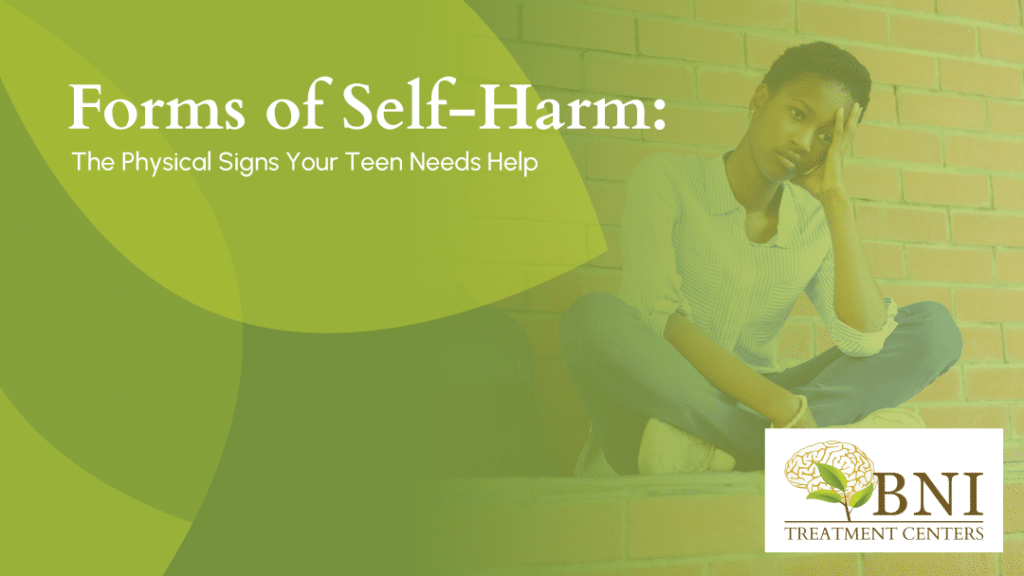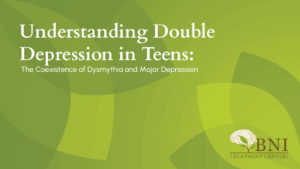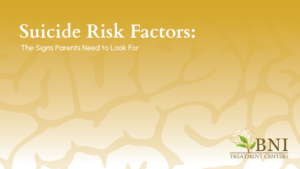
If you suspect your teen is self-harming, it can be overwhelming. Worry, concern, and even panic might set in – feelings of failure, or protectiveness. Many parents are left wondering, Is it my fault? I’ve tried everything and it hasn’t worked! What can I do?
You aren’t alone. At BNI Treatment Centers, we understand the fear and confusion that can surround these behaviors. Our psychiatrist-led team works with teens who self-harm and their families every day, to treat, educate, and support their recovery.
One of the first steps you can take to protect those you love is to learn the different forms self-harm can take.
Why Do People Self-Harm?
Self-harm happens for a variety of reasons. Some teens feel emotionally numb, and they’ll use self-harm as a way to feel something. Others use it to distract from painful ideas or emotions, such as guilt, anxiety, or loneliness. Self-harm is often used as a way of feeling control, either of the individual’s body or their emotions.
Self-harm is most often the result of both underlying mental health conditions and social factors. Research finds that more than a third of teens who live with depression have self-harmed, with other factors like home environment and interpersonal relationships playing a role. Coping with these complex disorders can result in self-harm or other destructive behaviors.
It is important for parents to make the distinction between self-harming behaviors and suicide attempts. These are not the same. While self-harm often coincides with other behavioral health diagnoses, suicide is not the intended effect.

Forms of Self Harm
Cutting
One of the most common forms of self-harm is cutting. This can involve the arms, legs, or other body parts. Key signs include scars, fresh cuts, or your teen hiding their arms and legs with long clothing.
Burning
Another form of self-harm involves burning with cigarettes, matches, or lighters. These burns can range from mild to severe, depending on the intensity and duration of the heat source. Some teens create friction burns by rubbing erasers or other materials against their skin.
Impact with Objects
Some teens self-harm by hitting themselves, typically with heavy or solid objects, though they may use their own hands or body to cause harm as well. This can be for the feeling of pain, the resulting bruises and marks, or both. Physical striking can potentially lead to fractures, bleeding, or other more serious injuries.
Neglecting to Eat
Teens sometimes self-harm by limiting their food or water intake, potentially leading to malnourishment and dehydration. This form of self-harm is often associated with eating disorders, such as anorexia or bulimia, and can have severe consequences for physical and psychological health. It is crucial to get a complete diagnosis when eating habits are involved.
Other Forms of Self-Harm
There are many other ways that a teen might intentionally harm themselves. These include swallowing toxic substances, pinching or scraping their skin, and even picking at scabs to prevent healing. While your child may self-harm for a wide variety of reasons, understanding these methods will help you stay aware and keep your loved ones safe.
How to Help Someone Who Self-Harms
If your teen is self-harming, it’s essential to approach the situation with understanding and care. Self-harm often indicates underlying mental health conditions, emotional distress, and feelings of isolation or powerlessness. The first step is always to empathize and offer non-judgmental support.
Certain coping strategies can help combat their urge to self-harm. These include deep breathing, exploring creative outlets, and physical activity. In some cases, you might look to harm-minimization strategies for your teen, such as flicking a rubber band on the wrist, or drawing lines on the skin instead of cutting. It’s important that they feel in control over any strategy, and aren’t forced to do something they don’t believe in.
However, it is equally important to take self-harm seriously. While there remains an important distinction between self-harm and suicide, research has shown that there is a strong link between the two. In the event your teen is exhibiting any of these behaviors, it is always worth consulting a mental health professional.

Treatment for Self-Harming Behavior
Self-harming behavior has a wide variety of treatments and approaches, ranging from teaching better coping mechanisms, treating the underlying conditions, or direct therapy. Two common and effective therapeutic approaches are cognitive-behavioral therapy (CBT) and dialectical-behavioral therapy (DBT). In CBT, the goal is to replace patterns of thoughts and urges with healthier counterparts. In DBT, the goal is to develop underlying mental skills, such as mindfulness, tolerance, and emotional regulation.
While both of these therapies are effective, every individual will ultimately be unique. Effective treatment for self-harm often involves a combination of therapy and medication. This makes clinical psychiatrists especially equipped to handle these behaviors. That’s why at BNI, our teams are led by our renowned psychiatrists, and they are intimately involved in every step of your teen’s behavioral health treatment.
BNI Treatment Centers is a behavioral health treatment facility for teens ages 12-17, located in the Los Angeles area. Our psychiatrist-led team provides counseling for self-harm, management of any co-occurring disorders, and treatment strategies tailored to your teen’s needs. Reach out to us at (888) 522-1504 to get to know our world class team.
BNI Treatment Centers: Science-based, evidence-backed, compassion-led.
Frequently Asked Questions
What are signs someone has been self-harming?
Common signs include frequent or unexplained bruises, cuts, scrapes, and other injuries. The individual may wear long-sleeved clothing even in hot weather, attempting to conceal scars or other marks. Additionally, they may begin acting secretive, withdrawn, and sensitive to their privacy.
Is self-harm a suicide attempt?
Generally self-harm and suicidal behavior are separate from one another. However, self-harm can lead to unintentional injuries or escalate to suicidal thoughts. It’s important to take self-harm seriously and seek professional help if needed.
Why do people self-harm?
It’s important to remember that every individual has their own motivation to self-harm. Common reasons include expressing or coping with emotional distress, attempting to feel control of their life, a response to intrusive thoughts, or even a cry for help.




